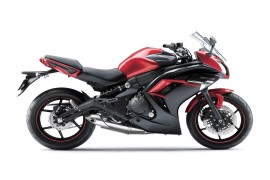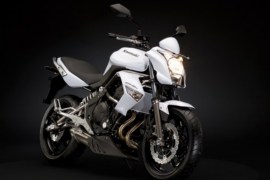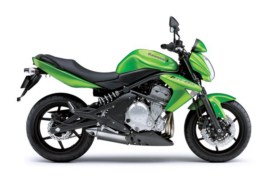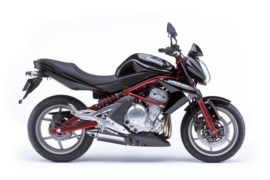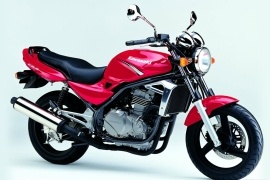KAWASAKI ER Models/Series Timeline, Specifications & Photos
First production year: 1996
In 2016, the Japanese motorcycle manufacturer launched the Kawasaki ER-6f, the faired brother of the ER-6n. The modern motorcycle was built on the perimeter frame dressed in an angular bodywork with a sporty windscreen.
The Kawasaki ER-6f debuted in 2006 and was known as the Ninja 650R or EX-6. The faired model had a naked brother that also debuted in 2006 but was sold into the American market only from 2009.
The 2006 faired model featured an agile stance and was fitted with standard features, such as a full fairing with a dual headlight system, a small and sporty windscreen, a two-piece dual seat with passenger grab handles, an under-belly exhaust system, and six-spoke lightweight wheels.
The motorcycle was built around a perimeter high tensile steel frame with a 41 mm traditional telescopic fork on the front and an offset lay-down preload-adjustable shock absorber on the rear, offering excellent handling.
As for the braking performance, the bike's wheels were fitted with two 300 mm semi-floating petal discs tied to dual-piston calipers on the front and a 220 mm petal disc coupled to a single-piston caliper on the rear.
Underneath its full fairing, the 2016 Kawasaki ER-6f had hidden from plain sight a 649cc four-stroke liquid-cooled parallel-twin engine fed by an electronically controlled fuel injection system, boasting 72 hp at 8,500 rpm and 64 Nm (47 lb-ft) torque at 7,000 rpm.
The Kawasaki Ninja 650R was a standard motorcycle manufactured by Kawasaki from 2006, alongside its naked brother, the Kawasaki ER-6n. The naked version was sold in the market American market from 2009.
In 2008, the Japanese motorcycle manufacturer launched the Kawasaki ER-6n, where "n" indicates the naked style. The bike was in its third year of production and packed the same technical, visual, and performance specifications as previous models without any modifications whatsoever.
The bike's visual department was represented by a vertically-stacked headlight, small side panels with integrated signals, a one-piece dual seat with pillion grab rails, a two-into-one exhaust system with a silencer mounted under the engine, and six-spoke lightweight wheels.
The bike shared the suspension system with previous models, packing a 41 mm traditional telescopic fork on the front and an offset lay-down preload-adjustable shock absorber on the rear, offering excellent handling capabilities.
It also carried the braking system from its siblings, packing two 300 mm semi-floating petal discs with dual-piston calipers on the front wheel and a 220 mm petal disc with a single-piston caliper on the rear, providing excellent stopping power.
As for the power figures, the 2008 Kawasaki ER-6n was brought to life by a 649cc four-stroke twin-cylinder liquid-cooled engine with a fuel injection system in charge, delivering 72 hp at 8,500 rpm and 66 Nm (49 lb-ft) torque at 7,000 rpm.
In 2008, the Japanese motorcycle manufacturer launched the Kawasaki ER-6n, a standard motorcycle that debuted in 2006. The ER-6n model was the naked brother of the ER-6f and was sold in the American market from 2009.
The 2007 Kawasaki ER-6n was in its second year of production. It came with the same package as the previous model, packing the same technical, visual, and performance specifications without any significant modifications, except for the color scheme.
In the visual department, the naked bike was fitted with standard features, such as a vertically-stacked dual headlight unit, small side panels with integrated turn signals, a one-piece dual seat with passenger grab rails, an under-belly exhaust system, and six-spoke lightweight wheels.
The bike was built around a diamond high tensile steel frame, wearing a 41 mm conventional telescopic fork on the front as a suspension and an offset lay-down shock absorber on the rear with preload adjustment, offering optimum handling capabilities.
In the braking department, the motorcycle packed two semi-floating 300 mm petal discs with dual-piston calipers on the front wheel and a 220 mm petal disc with a single-piston caliper on the rear wheel, offering excellent stopping power.
Underneath its fuel tank, the 2007 Kawasaki ER-6n had installed a 649cc four-stroke liquid-cooled twin-cylinder engine managed by a fuel injection system, boasting 72 hp at 8,500 rpm and 66 Nm (49 lb-ft) torque at 7,000 rpm.
The Kawasaki Ninja 650R, also known as the EX-6 or ER-6f, was a standard motorcycle part of the Ninja series, presented in 2005 and sold from 2006. When it was introduced in 2006, the ER-6f came alongside its naked brother, ER-6n.
Both motorcycles were introduced in 2006, while the Kawasaki ER-6n was sold in the American market from 2009. The bike filled the gap between the Kawasaki Ninja 250R and Ninja 500R.
In the aesthetic department, the ER-6n model packed a front cowl with a dual vertically-stacked headlight system, a side panel on each side with integrated turn signals, a one-piece dual seat with passenger grab rails, an under-belly exhaust system, and six-spoke lightweight aluminum wheels.
The motorcycle was built on a diamond high tensile steel frame with a 41 mm telescopic fork on the front and an offset laid-down preload-adjustable shock absorber on the rear, offering excellent handling capabilities.
As for the braking power, the bike packed two semi-floating 300 mm petal discs tied to dual-piston calipers on the front wheel and a 220 mm petal disc with a single-piston caliper on the rear wheel, providing excellent stopping power.
In the performance department, the 2006 Kawasaki ER-6n had installed in plain sight a 649cc four-stroke twin-cylinder liquid-cooled engine with a fuel injection system in charge, boasting 72 hp at 8,500 rpm and 66 Nm (49 lb-ft) torque at 7,000 rpm.
The Kawasaki ER-5 was a naked motorcycle intended as a commuter. The bike was manufactured from 1997 until 2006, when it was replaced by the Kawasaki ER-6. At its core was a 498cc four-stroke parallel-twin engine based on the one used by the GPZ500.
Unlike many modern motorcycles with modern brakes, such as a fixed caliper and a floating brake disc, the Kawasaki ER-5 installed a fixed brake disc, a floating caliper, and a drum braking unit on the rear.
The bike's aesthetic department was represented by a round headlight with instruments mounted on top, a one-piece dual seat with a passenger grab handle, a two-into-one exhaust system with a silencer mounted on the right side, and lightweight three-spoke aluminum wheels.
The motorcycle was built around a lightweight aluminum monocoque frame with a conventional telescopic fork on the front and five-way adjustable twin shock absorbers on the rear, providing optimum suspension performance and handling.
The braking performance was handled by a 280 mm disc with a dual-piston caliper on the front wheel and a 160 mm drum braking unit on the rear wheel, offering acceptable stopping power when riding solo.
As for the power figures, the 1996 Kawasaki ER-5 had installed underneath its fuel tank a 498cc four-stroke liquid-cooled twin-cylinder engine that delivered 49 hp with a peak force at 8,500 rpm and 43 Nm (32 lb-ft) torque at 7,200 rpm.
